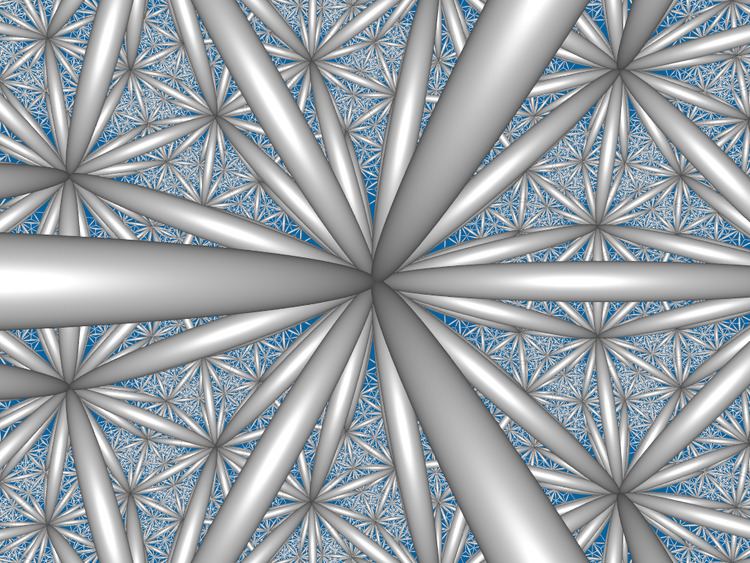 | ||
In geometry, uniform honeycombs in hyperbolic space are tessellations of convex uniform polyhedron cells. In 3-dimensional hyperbolic space there are 23 Coxeter group families of paracompact uniform honeycombs, generated as Wythoff constructions, and represented by ring permutations of the Coxeter diagrams for each family. These families can produce uniform honeycombs with infinite or unbounded facets or vertex figure, including ideal vertices at infinity, similar to the hyperbolic uniform tilings in 2-dimensions.
Contents
- Regular paracompact honeycombs
- Coxeter groups of paracompact uniform honeycombs
- 634 family
- 636 family
- 363 family
- 443 family
- 444 family
- 3411 family
- 4411 family
- 6311 family
- 4433 family
- 4443 family
- 4444 family
- 6333 family
- 6343 family
- 6353 family
- 6363 family
- 333 family
- 433 family
- 533 family
- 633 family
- 3 family
- Loop n tail graphs
- References
Regular paracompact honeycombs
Of the uniform paracompact H3 honeycombs, 11 are regular, meaning that their group of symmetries acts transitively on their flags. These have Schläfli symbol {3,3,6}, {6,3,3}, {3,4,4}, {4,4,3}, {3,6,3}, {4,3,6}, {6,3,4}, {4,4,4}, {5,3,6}, {6,3,5}, and {6,3,6}, and are shown below.
Coxeter groups of paracompact uniform honeycombs
This is a complete enumeration of the 151 unique Wythoffian paracompact uniform honeycombs generated from tetrahedral fundamental domains (rank 4 paracompact coxeter groups). The honeycombs are indexed here for cross-referencing duplicate forms, with brackets around the nonprimary constructions.
The alternations are listed, but are either repeats or don't generate uniform solutions. Single-hole alternations represent a mirror removal operation. If an end-node is removed, another simplex (tetrahedral) family is generated. If a hole has two branches, a Vinberg polytope is generated, although only Vinberg polytope with mirror symmetry are related to the simplex groups, and their uniform honeycombs have not been systematically explored. These nonsimplectic (pyramidal) Coxeter groups are not enumerated on this page, except as special cases of half groups of the tetrahedral ones.
The complete list of nonsimplectic (non-tetrahedral) paracompact Coxeter groups was published by P. Tumarkin in 2003. The smallest paracompact form in H3 can be represented by or , or [∞,3,3,∞] which can be constructed by a mirror removal of paracompact hyperbolic group [3,4,4] as [3,4,1+,4] : = . The doubled fundamental domain changes from a tetrahedron into a quadrilateral pyramid. Another pyramid is or , constructed as [4,4,1+,4] = [∞,4,4,∞] : = .
Removing a mirror from some of the cyclic hyperbolic Coxeter graphs become bow-tie graphs: [(3,3,4,1+,4)] = [((3,∞,3)),((3,∞,3))] or , [(3,4,4,1+,4)] = [((4,∞,3)),((3,∞,4))] or , [(4,4,4,1+,4)] = [((4,∞,4)),((4,∞,4))] or . = , = , = .
Another nonsimplectic half groups is ↔ .
A radial nonsimplectic subgroup is ↔ , which can be doubled into a triangular prism domain as ↔ .
[6,3,4] family
There are 15 forms, generated by ring permutations of the Coxeter group: [6,3,4] or
[6,3,6] family
There are 9 forms, generated by ring permutations of the Coxeter group: [6,3,6] or
[3,6,3] family
There are 9 forms, generated by ring permutations of the Coxeter group: [3,6,3] or
[4,4,3] family
There are 15 forms, generated by ring permutations of the Coxeter group: [4,4,3] or
[4,4,4] family
There are 9 forms, generated by ring permutations of the Coxeter group: [4,4,4] or .
[3,41,1] family
There are 11 forms (of which only 4 are not shared with the [4,4,3] family), generated by ring permutations of the Coxeter group:
[4,41,1] family
There are 7 forms, (all shared with [4,4,4] family), generated by ring permutations of the Coxeter group:
[6,31,1] family
There are 11 forms (and only 4 not shared with [6,3,4] family), generated by ring permutations of the Coxeter group: [6,31,1] or .
[(4,4,3,3)] family
There are 11 forms, 4 unique to this family, generated by ring permutations of the Coxeter group: , with ↔ .
[(4,4,4,3)] family
There are 9 forms, generated by ring permutations of the Coxeter group: .
[(4,4,4,4)] family
There are 5 forms, 1 unique, generated by ring permutations of the Coxeter group: . Repeat constructions are related as: ↔ , ↔ , and ↔ .
[(6,3,3,3)] family
There are 9 forms, generated by ring permutations of the Coxeter group: .
[(6,3,4,3)] family
There are 9 forms, generated by ring permutations of the Coxeter group:
[(6,3,5,3)] family
There are 9 forms, generated by ring permutations of the Coxeter group:
[(6,3,6,3)] family
There are 6 forms, generated by ring permutations of the Coxeter group: .
[3,3[3]] family
There are 11 forms, 4 unique, generated by ring permutations of the Coxeter group: [3,3[3]] or . 7 are half symmetry forms of [3,3,6]: ↔ .
[4,3[3]] family
There are 11 forms, 4 unique, generated by ring permutations of the Coxeter group: [4,3[3]] or . 7 are half symmetry forms of [4,3,6]: ↔ .
[5,3[3]] family
There are 11 forms, 4 unique, generated by ring permutations of the Coxeter group: [5,3[3]] or . 7 are half symmetry forms of [5,3,6]: ↔ .
[6,3[3]] family
There are 11 forms, 4 unique, generated by ring permutations of the Coxeter group: [6,3[3]] or . 7 are half symmetry forms of [6,3,6]: ↔ .
[3[ ]×[ ]] family
There are 8 forms, 1 unique, generated by ring permutations of the Coxeter group: . Two are duplicated as ↔ , two as ↔ , and three as ↔ .
[3[3,3]] family
There are 4 forms, 0 unique, generated by ring permutations of the Coxeter group: . They are repeated in four families: ↔ (index 2 subgroup), ↔ (index 4 subgroup), ↔ (index 6 subgroup), and ↔ (index 24 subgroup).
Loop-n-tail graphs
Symmetry in these graphs can be doubled by adding a mirror: [1[n,3[3]]] = [n,3,6]. Therefore ring-symmetry graphs are repeated in the linear graph families.
